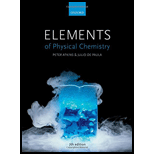
(a)
Interpretation:
The ester concentration left after 15 seconds of reaction between ethyl acetate and sodium hydroxide with given initial concentration has to be calculated.
Concept Introduction:
Second order reaction: If here are two reactant molecules are involving in a reaction, then the order of the reaction is two. So, such a reaction is known as a second order reaction.
General representation of a second order reaction is as follows:
Rate law for second order reaction is given below:
Integrated rate law for the second order reaction is given below:
(a)
Explanation of Solution
The ester concentration left after 15 seconds for given reaction is given as follows,
(b)
Interpretation:
The ester concentration left after 15 minutes of reaction between ethyl acetate and sodium hydroxide with given initial concentration has to be calculated.
Concept Introduction:
Second order reaction: If here are two reactant molecules are involving in a reaction, then the order of the reaction is two. So, such a reaction is known as a second order reaction.
General representation of a second order reaction is as follows:
Rate law for second order reaction is given below:
Integrated rate law for the second order reaction is given below:
(b)
Explanation of Solution
The ester concentration left after 15 seconds for given reaction is given as follows,
Want to see more full solutions like this?
Chapter 6 Solutions
Elements Of Physical Chemistry
 ChemistryChemistryISBN:9781305957404Author:Steven S. Zumdahl, Susan A. Zumdahl, Donald J. DeCostePublisher:Cengage Learning
ChemistryChemistryISBN:9781305957404Author:Steven S. Zumdahl, Susan A. Zumdahl, Donald J. DeCostePublisher:Cengage Learning ChemistryChemistryISBN:9781259911156Author:Raymond Chang Dr., Jason Overby ProfessorPublisher:McGraw-Hill Education
ChemistryChemistryISBN:9781259911156Author:Raymond Chang Dr., Jason Overby ProfessorPublisher:McGraw-Hill Education Principles of Instrumental AnalysisChemistryISBN:9781305577213Author:Douglas A. Skoog, F. James Holler, Stanley R. CrouchPublisher:Cengage Learning
Principles of Instrumental AnalysisChemistryISBN:9781305577213Author:Douglas A. Skoog, F. James Holler, Stanley R. CrouchPublisher:Cengage Learning Organic ChemistryChemistryISBN:9780078021558Author:Janice Gorzynski Smith Dr.Publisher:McGraw-Hill Education
Organic ChemistryChemistryISBN:9780078021558Author:Janice Gorzynski Smith Dr.Publisher:McGraw-Hill Education Chemistry: Principles and ReactionsChemistryISBN:9781305079373Author:William L. Masterton, Cecile N. HurleyPublisher:Cengage Learning
Chemistry: Principles and ReactionsChemistryISBN:9781305079373Author:William L. Masterton, Cecile N. HurleyPublisher:Cengage Learning Elementary Principles of Chemical Processes, Bind...ChemistryISBN:9781118431221Author:Richard M. Felder, Ronald W. Rousseau, Lisa G. BullardPublisher:WILEY
Elementary Principles of Chemical Processes, Bind...ChemistryISBN:9781118431221Author:Richard M. Felder, Ronald W. Rousseau, Lisa G. BullardPublisher:WILEY





